RARE! WWII 1944'Hollandia Drome' Japanese Airfield Double Sided Infantry Map
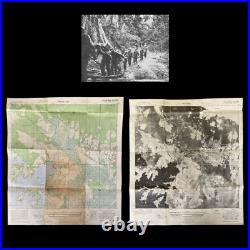
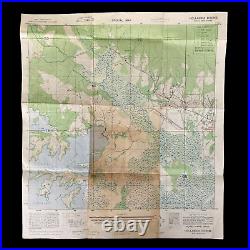
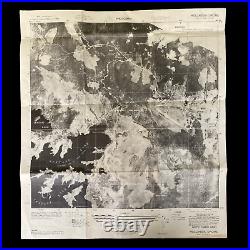
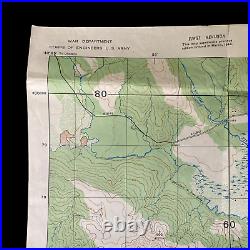
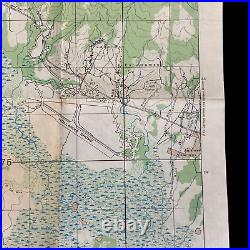
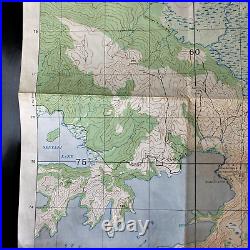
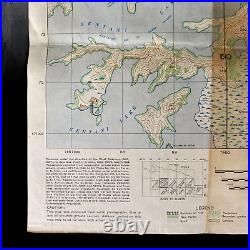
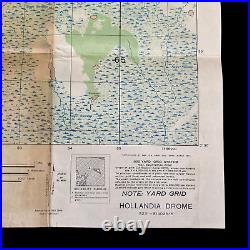
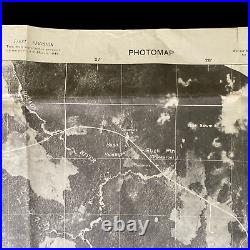
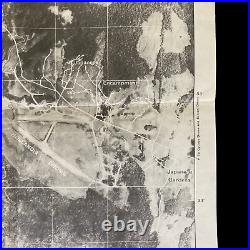
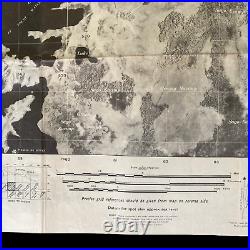
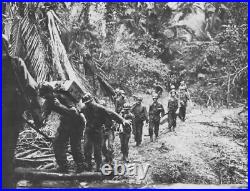

Prepared under the direction of the Chief Engineer this extremely rare double side infantry movement and rare'AERIAL SUPPORT PHOTO' map was used in support of the Operation Reckless Task Force assault on the Japanese held Hollandia Drome airfield and later in support of the Operation Reckless Task Force Amphibious movement on Lake Sentani and the capture of the Japanese-held Sentani Drome and Cyclops Drome. One of the most famous pictures of the Operation Reckless campaign shows LVT's crossing Lake Sentani with the 9th Air Force B-25's flying overhead.
Titled "Hollandia Drome - Dutch New Guinea" This map was constructed from large-scale vertical area photograph missions 43Y (February 1944) and 282W (October 1943) by 8th Photo squadron, 5th Air Force and 56Y (February 1944) by 25th Photo Squadron 5th Air Force. This map also features a rare'PHOTO MAP' on the backside showing a realistic view of the Japanese airfield (Hollandia Drome) and terrain from the air. The map also features Lake Sentani which would be later amphibiously navigated on the later assault of the Sentani Drome and Cyclops Drome. These backside'PHOTO MAPS' are not common and are generally reserved for special divisions and operations.
This map was printed a month before (March 1944) of the D-Day amphibious landings in Tanahmerah Bay (April 1944). The'Road Classification and'Legend' were vital to mission success as the infantry navigated the land from RED BEACH 1/RED BEACH 2 to assault Hollandia Drome and begin plans to cross Lake Sentani. After passing an uneventful night, the 1st and 3d Battalions, 21st Infantry, resumed the advance at 0830 on 26 April. There was no opposition as the main bodies moved across the Dajaoe River and on through Julianadorp.About 1130 both units stopped at Ebeli Plantation, about 1,800 yards east of Julianadorp, to clear out a bunker which was occupied by four Japanese riflemen. While the 3d Battalion dispatched Company L north some 600 yards off the main trail to flush some Japanese from Ebeli Sawmill, the rest of the troops moved on eastward. By noon advance elements were atop a hill whence they could see the inland airfields, and minutes later forward patrols reached the outermost dispersal areas of Hollandia Drome, the most westerly of the three Japanese airfields on the plain north of Lake Sentani.
Now the advance was halted as the battalions regrouped and Colonel Lyman issued a new attack order. The 1st Battalion was instructed to clear a Japanese encampment area left of the trail and north of the center of Hollandia Drome. The 3d Battalion was to push directly on to the airfield, secure it, and then advance as far as the edge of a swamp lying southeast of the strip. By 1350 the 1st Battalion had secured its objective, having encountered little resistance. The 3d Battalion's forward patrols reached the western edge of the main runway about the same time and, locating no opposition worthy of mention, arrived at the eastern end of the field half an hour later.
At 1530 Colonel Lyman radioed to division headquarters that the entire Hollandia Drome area had been secured. By dark the 2d Battalion, 21st Infantry, had closed at Hollandia Drome. The bad weather which had forced cancellation of attempted airdrops on 24 and 25 April had finally broken sufficiently for a few planes from eastern New Guinea to get through to Hollandia.
Twelve B-25's of the 17th Reconnaissance Squadron, Fifth Air Force, flew the nearly 500 miles from Saidor to drop rifle, carbine, machine gun, and mortar ammunition, hand grenades, and rations at Dazai. Moreover, the 2d Battalion, 21st Infantry, had managed to bring forward some extra rations, ammunition, and medical equipment. As the rain stopped, fresh carrying parties following the 2d Battalion found trail conditions greatly improved. Finally, some wheeled transport was now available at both ends of the Dépapré-Lake Sentani road.
Hard work by engineers had made the road passable for jeeps from Dépapré halfway up the first steep slopes of the Takari Hills. At Hollandia Drome the 21st Infantry had captured a few Japanese trucks.These were sent west from the airstrip as far as possible along the main trail, which was passable to a point near Julianadorp. There the supplies dropped from the air during the day, as well as those still being hand-carried overland from Dépapré, were picked up and taken back to the airfield area. As soon as Hollandia Drome was secured, patrols of the 21st Infantry pushed on toward Weversdorp, a farm about 2,500 yards beyond the eastern end of the field. At 1645, between Weversdorp and the airdrome, contact was established with elements of the 186th Infantry, 41st Division, which had been attacking westward from Humboldt Bay into the airfield area. By 1430 the 3d Battalion had cleared Jarremoh Hill and was digging in for the night along a ridge overlooking Hollandia.
The battalion commander wanted to push on into the town before dark, but General Fuller, commanding the 41st Division, vetoed this proposal. On the basis of intelligence reports which indicated that the Japanese were occupying Hollandia in some strength, General Fuller had decided that the seizure of the town would have to wait until the morning of the 23d. During the night naval guns and 105-mm.
Howitzers of the 146th Field Artillery Battalion--emplaced on firm ground north of WHITE Beach 1--bombarded Hollandia, softening the 3d Battalion's task for the morrow. In the meantime the 2d Battalion had begun advancing from WHITE Beach 1 to the track connecting Hollandia with Pim, on the western shore of Jautefa Bay.
Company E led off on the left at 0756, moving past. The southwest side of Pancake Hill, while Company G took a route east of the hill. The rest of the battalion soon started out after Company E but found the terrain west of Pancake Hill unexpectedly swampy and rough going for a large body of troops. The battalion commander therefore ordered the units on that side to turn and follow Company G. Company E kept on overland and quickly reached the Pim-Hollandia track at a point about 1,000 yards west of Pancake Hill. By midmorning Company G had arrived on the trail north of Company E. The rest of the battalion concentrated on the trail between Companies E and G early in the afternoon. Contact was soon established with the company of the 3d Battalion which had advanced to the Pim-Hollandia road from Pancake Hill earlier in the day. The 2d Battalion then moved up the road toward Hollandia, and by nightfall had joined the 3d on the ridge overlooking the town. Meanwhile, the 1st Battalion had assembled as division reserve at the base of Pancake Hill. By dark on the 22d the 162d Infantry had carried its advance to the 41st Division's first phase line. To that time, opposition had been so light that American casualties, including those of the 186th Infantry, totaled only six men killed and sixteen wounded. As at Tanahmerah Bay, the Japanese had made no effort to man their prepared defenses which, though not as extensive as had been expected, could have produced considerable trouble for the 41st Division. The division staff was both pleased and worried by the lack of enemy resistance and could make no estimate as to the character of Japanese opposition which might be met on the 23d. Nevertheless, since it was expected that the 162d Infantry would have little trouble in seizing Hollandia, that action was ordered. The 2d and 3d Battalions, 162d Infantry, jumped off at 0730 on the 23d. The units moved rapidly down the ridge to Hollandia and at 1115 reported that they had secured the town. The 1st Battalion, 162d Infantry, had meanwhile relieved a battalion of the 186th Infantry which had been waiting in division reserve west of Pancake Hill. The 2d Battalion, 162d Infantry, after helping the 3d to secure Hollandia, moved into high ground west and northwest of that town. During the remainder of the attack phase of the Hollandia operation, the entire 162d Infantry patrolled the hilly environs of Hollandia, securing the northern shores of Humboldt Bay, the beaches of Challenger Cove, and rough hills along the western side of Jautefa Bay. To the 186th Infantry fell the task of driving inland to the main objective, the airfields on the north shore of Lake Sentani. Amphibious Movement on Lake Sentani. Colonel Newman ordered the 3d Battalion, 186th Infantry, to move west along the main road to Nefaar, six and one half miles beyond the night bivouac area.The 1st Battalion was to load on LVT's at the jetty which had been captured the previous afternoon. From that jetty, the troops were to move by LVT over Lake Sentani to a point on the shore west of Nefaar and, upon landing, help the 1st Battalion to secure that village. Two companies of the 2d Battalion were to clear scattered enemy troops from high ground on the right flank, whence the Japanese had harassed the battalion's night bivouac. As soon as this task was accomplished, the 2d Battalion would reassemble as regimental reserve and follow the 3d along the main track toward Nefaar. Company I had not reached the 3d Battalion the previous day and was therefore ordered to operate with the 1st Battalion, at the perimeter of which it had arrived just before dark.
Company B was lent to the 3d Battalion to bring that unit up to full strength for the advance west. LVT's of the 2d Engineer Special Brigade had now moved up to the jetty which the 3d Battalion had captured the previous day. There, at 1000, two companies of the 1st Battalion loaded on the amphibians and departed for Nefaar. No Japanese fire from the shores of Lake Sentani greeted this landlocked amphibious maneuver, and at 1150 two companies landed at Nefaar. The remainder of the 1st Battalion moved by LVT to Nefaar later in the day and at 1530 the 3d Battalion reached that village after an uneventful march overland.The 2d Battalion closed on the village shortly thereafter. Vigorous patrolling north and west of Nefaar characterized action the rest of the afternoon, during which only slight resistance was encountered. Expected strong enemy opposition had not as yet materialized, but before dark a platoon of Company A made a brief reconnaissance of Cyclops Drome, most easterly of the three Japanese fields on the north shore of Lake Sentani, and reported evidences of considerable enemy movement and strong defensive positions. Despite these reports, Colonel Newman was confident that his troops would have little or no difficulty in securing Cyclops.
Drome on the 26th, for he now believed that the enemy had vacated the airfield area. One of the reasons that the 186th Infantry had not reached the airdromes on the afternoon of 25 April was that artillery fire was falling on those fields. Some of this fire may have been from the 155-mm. Weapons of the 11th or 168th Field Artillery Battalions, emplaced on the 24th Division's beaches at Tanahmerah Bay, but other artillery fire was undoubtedly from Japanese dual-purpose weapons dug in north of the airfields. Whatever the case, communications difficulties prevented the fire from the 24th Division's area being stopped before the time came for the 186th Infantry to set up night defenses.The 1st Battalion bivouacked about 1,700 yards west of Nefaar and placed outposts in high ground 700 yards north of the main trail. The 3d Battalion went into position about 1,000 yards behind the 1st, while the 2d remained at Nefaar for the night. For the morrow, Colonel Newman ordered the 1st Battalion to seize the northwestern half of Cyclops Drome. One company of the 3d was to secure the southeastern part of the field and the remainder of the battalion was to act as general reserve. The 2d Battalion was to move by LVT from Nefaar to another jetty located about 2,000 yards southeast of Sentani Drome and the village of Ifaar.
Pushing rapidly up a trail from the jetty to Ifaar, the battalion was to seize that village and Sentani Drome. The 1st and 2d Battalions moved out as planned shortly after 0800 on the 26th. By 1040 the 1st Battalion had secured Cyclops Drome against no opposition.
About 1000, Companies F and G of the 2d Battalion landed against scattered rifle fire at the jetty below Ifaar, a mile overwater from Nefaar. The rest of the battalion came ashore in the same area in the early afternoon. Advance elements of the 2d Battalion were on Sentani Drome at 1130, and by 1215 the battalion commander was able to report that the airfield and its environs had been secured.During the remainder of the afternoon patrol action around both airfields accounted for a few Japanese stragglers. Opposition throughout the day had been conspicuous by its absence--the Japanese had disappeared.
The 3d Battalion moved up to the airstrips before dark, and at nightfall the entire 186th Infantry set up a defensive perimeter around Cyclops and Sentani Dromes. Patrols of the 1st Battalion were sent west beyond the fields and at 1645 made contact with patrols of the 21st Infantry between Weversdorp and Hollandia Drome. This contact completed the pincers movement instituted by the 24th and 41st Divisions on 22 April. All important objectives of the RECKLESS Task Force had been secured. This item is in the category "Collectibles\Militaria\WW II (1939-45)\Original Period Items\United States\Field Gear, Equipment".
The seller is "premierrelics" and is located in this country: US. This item can be shipped worldwide.
- Theme: Militaria
- Original/Reproduction: Original
- Conflict: WW II (1939-45)
